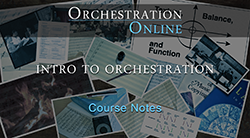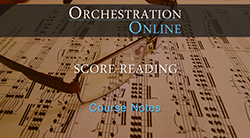B-flat Transposition Course
The B-flat Transposition Course is extracted from my latest Orchestration Training Course, 102: The Wind Section available from macProVideo and AskVideo. It’s designed to get a beginning to intermediate score-reader up to speed with transposing B-flat notation at sight, quickly making sense of the most common transposition in orchestral scoring. As I say in the above video, “through transcription, dictation, sight-singing, score-reading, and the identification of single pitches and harmonies, you’ll learn to think of Bb as a comfortable old shoe.” Open the PDF on the right first, and try out the first three lessons, pacing yourself slowly so as to absorb the information and training over the course of a few days rather than all at once. Then take the 4th lesson in dictation from the video above, and finish it off with some score study in the 5th lesson.
It’s my strong hope that you’ll see this course as a first step rather than as the answer to all your transposition needs. Challenge yourself with other scores to study and recordings to transcribe, and put the resultant skills to work in scoring your own music. You’ll never have to press the “Transposing score” button in Sibelius again once you reach that point.
Intro to Orchestration

Intro to Orchestration is a 10-part series of video lectures about the realities of being a professional orchestrator. It’s got tips, advice, checklists of resources and training, development goals, and life lessons. The series starts with a professional orchestrator (me) talking off the top of his head into a cheap digital camera, but grows from there with diagrams, examples, music, and graphic art, all illustrating the principles and practice of an artistic life.
Somehow along the way this turned into a course, so PDF notes are provided above, which outline the content of each video, along with commentary and clarification. As of mid-2014, the series is incomplete, with two more videos to go. I will try to have these both uploaded by 2015.
Score-Reading

Score-Reading is a 6-part series of videos introducing the importance and practice of score-reading: what it is, how to do it, and why it should be an essential, daily part of a composer’s life. This was originally intended to be four videos, but I ran up against YouTube’s 10-minute time limit for new users back then, and had to spread the fourth chapter over 3 videos.
As with the Intro series, this playlist comes with course notes provided in a PDF above. The recommended scores are all linked in the PDF to their IMSLP pages for your convenience. Also, a link is provided to the Mozart Symphony no. 40, for you to download and score-read while listening to the remaining four videos of the playlist.
Orchestration Weekly Tips
Orchestration Weekly Tips kicked off the launch of the Orchestration Online Facebook Group. There were also a series of Daily Orchestration Tips, all of which have been archived on the Blog Page of this website. I really enjoyed shooting these videos and writing the tips. They’d make a great e-book someday. If there’s any way to return to this series, I’ll do so in the future.
Orchestration: Texture, Balance, and Function
Texture, Balance, and Function are the three fundamental elements of orchestration, which work interdependently to strengthen a score. The playlist above collects all of my significant videos on the topic, starting with my Intro course chapter (skip ahead if needed), then covering a series of lectures presented to the Composers Association of New Zealand (CANZ). One of these lectures will be published in the next issue of Canzona, their annual journal.
In this case, I don’t have to speculate about it. I am writing a book on this topic, which should come out in a couple of years, following the release of the next few orchestration courses on macProVideo and here on Orchestration Online.

